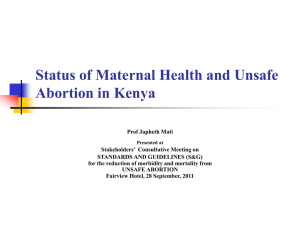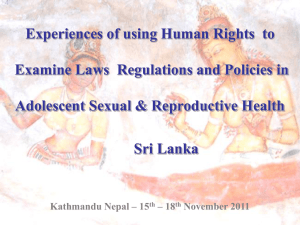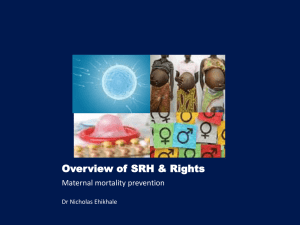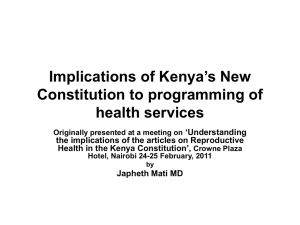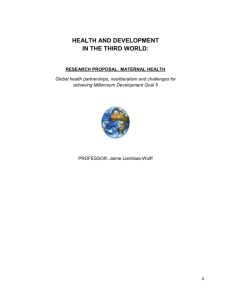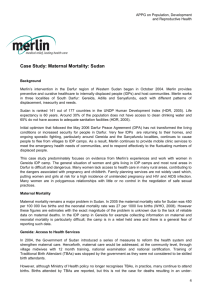Presentation by Prof Mati at KMA Conference Sept 15
advertisement
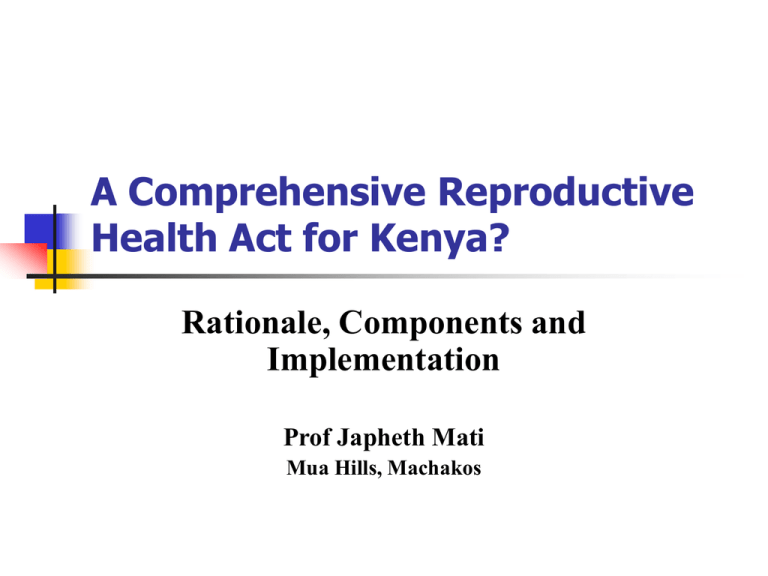
A Comprehensive Reproductive Health Act for Kenya? Rationale, Components and Implementation Prof Japheth Mati Mua Hills, Machakos KMA and Maternal Health Maternal health issues ought to feature among the top health priorities in KMA agenda (see below). Among the top four leading causes of death among women, Maternal Conditions rank second only to HIV/AIDS, but are at the top of causes of Disability Adjusted Live Years (DALY) lost It is appropriate that this conference has the theme: “The lives and Health of Women in Kenya are Worth Preserving: In Harmony with the New Constitution”. and Disease Burden in Women Ages 15-44 (Source: Global Disease Burden Project, 2006) CAUSES OF DEATH % of Total deaths CAUSES OF DALY LOST % of Total DALYs HIV/AIDS 25.5 Maternal Conditions 13.2 Maternal Conditions 13.5 HIV/AIDS 12.4 Cancer 7.9 Unipolar Depressive Disorders 11.2 Tuberculosis 6.4 Cancer 3.5 My given topic is: “Is it Time for a Comprehensive Reproductive Health Act for Kenya? Rationale, Components and Implementation” Right to Reproductive Health Art 43 (1) of the Constitution of Kenya Every person has the right— (a) to the highest attainable standard of health, which includes the right to health care services, including reproductive health care; Government’s obligations upon promulgation of the Constitution Guarantee and protect right to health including RH services for women and men Women and men have access to quality RH services Women have freedom to decide if, when and how often to reproduce Women survive pregnancy and child birth Factors that contribute to maternal morbidity and mortality are addressed Laws, policies and guidelines are in place to guarantee quality health care services. The Right to RH implies Guaranteed access to adequate RH care for all including poor and marginalised groups Addressing underlying determinants of health- water, food, clean environment etc., as provided for in Art. 43 (1) (b-f) are KMA & partners have crucial role to play in implementing health provisions in the Constitution The Constitution of Kenya provides opportunities for enhancing health, including RH and rights The Constitution addresses key factors that are fundamental to improving RH indicators- equality, equity, dignity and freedom from discrimination. The Constitution in Art. 26(4) has established under certain specified conditions, the entity of legal abortion. KMA, professional societies, and partners can play central roles especially in ensuring laws, policies and guidelines do reflect provisions in the Constitution for effective implementation of quality RH services Evidence-based interventions for reduction of maternal deaths Strengthening/ building efficient health infrastructure & human resources. (MMR is the best proxy of a functional health system) Prioritising most effective approaches to deliver key interventions Scaling up interventions that are known to work Ensuring interventions reach those who need them most Apply high-impact interventions to address lead causes of maternal death Examples of high-impact interventions Prevent unplanned pregnancy- access to efficient FP services Prevent unsafe abortion- access to safe abortion services Ensure skilled care throughout continuum of pregnancy, childbirth and postpartum period (define new role of TBA) Prevent PPH through active management of 3rd stage of labour (AMTSL) Family planning saves lives Ensuring access to efficient FP services: Reduces unwanted births- reducing risk of maternal deaths, Reduces unwanted pregnancies- reducing risk of unsafe abortion- reduce maternal death by 35% Birth spacing can reduce maternal morbidity and mortality. Birth spacing of 3-5 years associated with lower risk of APH, PE, PRM, puerperal endometritis and maternal death (Systematic reviews and meta-analyses). Right to life Article 26 Article 26: (1) Every person has the right to life. (2) The life of a person begins at conception. (3) A person shall not be deprived of life intentionally, except to the extent authorised by this Constitution or other written law. (4) Abortion is not permitted unless, in the opinion of a trained health professional, there is need for emergency treatment, or the life or health of the mother is in danger, or if permitted by any other written law. Art 26(4) Effectively recognises the entity of legal abortion in Kenya, though under certain specified conditions Arising from Art 26(4) a number of clarifications and definitions are needed, including: Who is a trained health professional? What legal issues arise from ‘Task shifting’ implied above? What constitutes danger to life or health of the mother? At what stage is emergency treatment mandatory? What definition of ‘health’ is implied- is it WHO’s? (i.e. “a state of complete physical, mental and social well-being…..) etc. etc. Who among these is implied in “trained health professional”? Obstetrician Gynaecologist? Registered medical practitioner? Registered Clinical Officer? Registered Nurse? Registered Midwife? Any health worker trained to competency? All of the above? Safe abortion services WHO definition of ‘safe abortion’ includes: Provided by trained health workers Using proper equipment Using correct techniques, in Functional well equipped health infrastructure, and Supported by policies and regulations Conditions for providing ‘safe abortion’ services within the law Requirements of Article 26(4) are met Conditions for WHO definition of ‘safe abortion’ are satisfied Under such scenario TOP is a legal safe medical procedure. TOP outside above conditions, it is “Unsafe abortion”. Denial of abortion services to women who are legally entitled to them What is the legal position of Conscientious Objection? What are the legal obligations of doctors invoking Conscientious Objection? What are legal responsibilities of such providers to women who seek abortion services? Other considerations in a comprehensive RH Act Access to services – physical access e.g. specified maximum distance to nearest health facility in all counties Minimum RH services that must be available in health facilities Minimum standards of quality of RH services Norms and standards of HR, equipment and supplies Other considerations -cont’d Basic (minimum) RH conditions that must be catered for at various KEPH levels Accreditation and inspection of health facilities (public and private) Training and roles of RH service providers including ‘task shifting’ Conclusions The Constitution of Kenya provides opportunities for enhancing health, including RH and rights The Constitution of Kenya addresses key factors crucial to reduction of maternal mortality- equality, equity, dignity and freedom from discrimination. The Constitution of Kenya in Art. 26(4) has established the entity of legal abortion, under certain specified conditions Conclusions There are several areas that require legal clarification in order to avoid unwarranted access barriers to services that are now legally sanctioned. KMA, professional societies, and partners can play key roles especially in ensuring laws, policies and guidelines do reflect provisions in the Constitution for effective implementation of quality RH services



